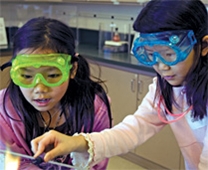Grant Spotlight | February 1, 2008
Share This |
Recipient: Grant: Web site: |
Contact: Lee Dawson, Publicist |
||
Part brain-powered playground for kids and adults, part cutting-edge classroom for communities across the state, the Oregon Museum of Science and Industry seeks to inspire wonder in each of its visitors.
Today, OMSI is one of the largest and most successful campuses of its kind in the country, offering 219,000 square feet of interactive exhibits, hands-on demonstrations, a big-screen OMNIMAX® Theater, the Northwest’s largest planetarium, and the USS Blueback—the last fast-attack, diesel-powered submarine built by the U.S. Navy, now decommissioned.
Visitors to the museum can touch a tornado, uncover a fossil, surf the Internet, enter the world of virtual reality, experience an earthquake, or simply experiment on their own in one of the many hands-on labs.
But just as OMSI bills itself as destination tourism for the science wizard in each of its visitors, it is equally passionate about bringing the love of science to thousands of classrooms and students who can’t always make the trip to Portland. Each year, OMSI reaches millions of people through direct visits, outreach programs, camps, classes, and after-school science clubs, traveling exhibits, and fairs—among the largest outreach of its kind in the nation.
With a range that reaches more than 200,000 students in six western states, including Alaska, OMSI is able to bring the museum experience directly to them through traveling programs and fairs—programs that include interactive presentations on forensics, live animal demonstrations, and the popular Discovery Dome Portable Planetarium.
A partnership with NASA known as STARS (Science, Technology, and Rural Students) delivers hands-on training to 250–300 teachers and librarians in more than 70 schools and 13 libraries, giving them special tools to engage students, curriculum help, direct access to science experts, and access to digital labs and live video to extend learning.
Another program, known as Facilitated Activities-based Videoconferencing, allows OMSI to conduct hands-on, interactive teacher professional development and classroom programs.
Teachers and students use supplies brought to them that day by a museum representative with videoconference support available from the entire museum education staff.
OMSI also places much of its focus on reaching out to underserved and minority populations. The Salmon Camp Research Team, for example, recruits Native American youth interested in protecting natural resources for future generations. Students from 46 tribes have taken part so far, being paired with professional mentors—rangers, ecologists, and university researchers—and using the latest professional field equipment and lab software for activities such as habitat surveys and stream modeling.
To serve inner-city young people, OMSI has created a Boys and Girls Science Club for low-income youth in north and northeast Portland. Each year this program—offered for free to the 10,000 children enrolled in local Boys and Girls Clubs—supplies students with a safe, stable, and supportive environment, while providing an on-site science educator, equipment, hands-on activities, and monthly field trips to the museum and other science-related sites.
As educators recognize a national need to engage children in science learning, the Oregon Museum of Science and Industry is innovating, finding new ways to reach students, teachers, and communities and show them that science, math, and technology are not only relevant, but fun, and indeed truly inspirational.
